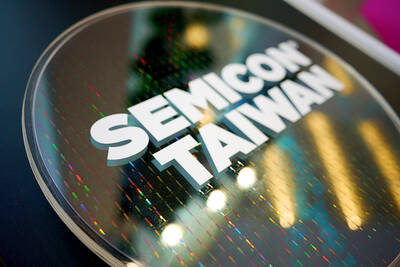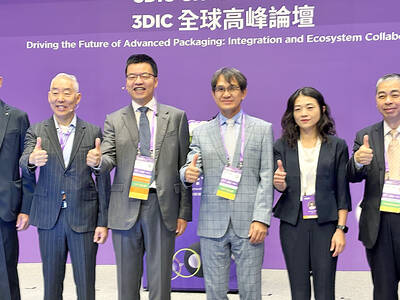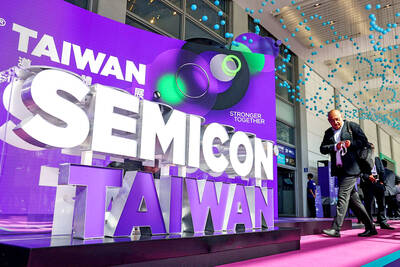MediaTek Inc (聯發科), the nation’s No. 1 handset chip designer, yesterday announced plans to acquire local rival MStar Semiconductor Inc (晨星半導體) in a deal worth NT$115 billion (US$3.84 billion), in an effort to broaden its product portfolio in the face of competition from rivals like Qualcomm Inc and China’s Spreadtrum Communications (展訊).
MediaTek said it planned to offer 0.794 of a MediaTek share and NT$1 in cash for every MStar share. The stock-and-cash offer would represent a 19.8 percent premium on Mstar’s closing price of NT$182.5 yesterday. MediaTek shares ended the day at NT$274.
“The merger will combine the advantages and resources of the two companies,” MediaTek chairman Tsai Ming-kai (蔡明介) told a media briefing. “The combination will enhance global competitiveness and maximize our product lineup. This is the most important target.”
Competition is intensifying as smartphones overtake feature phones as the preference of most mobile-phone users, Tsai said.
It was crucial to integrate handset chip technologies with TV chip technologies as products become smart, he added.
MStar accounts for about 50 percent of the world’s digital TV chip market and has rapidly expanded into the mobile-phone chip and set-top box chip markets in recent years.
“The industrial landscape is changing rapidly ... Competition is rising and business models are changing,” MStar chairman Wyne Liang (梁公偉) said. “This is a game of survival. A company can fall in the blink of an eye if it makes takes a wrong move.”
The merger would create the world’s fourth-biggest chip designer with annual revenue of US$4.2 billion last year, outranking Nvidia, according to figures from IC Insight.
Eric Chen (陳慧明), a semiconductor analyst at Daiwa Capital Markets, based in Hong Kong, said the announcement was a “big surprise.”
“We believe the acquisition will make MediaTek focus on Qualcomm, without bothering too much about competition from local competitors,” Chen said in a research note yesterday.
The acquisition would help MediaTek accelerate the expansion of its handset chip portfolio, especially smartphone chips to compete with Qualcomm, Chen said, adding that MediaTek would have stronger pricing power and more efficient research and development.
After the acquisition, MediaTek’s share of the global digital TV chip market would expand to more than 75 percent and its share of the handset chip market in China would grow to more than 60 percent, according to Chen’s calculations.
The merger is scheduled to be undertaken in two phases and completed in the first quarter of next year. In the first phase, MediaTek would buy up to 48 percent, or 254 million shares, on the open market from Monday through Aug. 13.
MediaTek expects the synergy from a tie-up with MStar to become evident within a year of the acquisition, based on its purchase of wireless chipmaker Ralink Technology Corp (雷凌) in October. Ralink is a fully owned subsidiary of MediaTek.
“The acquisition of Ralink helped us speed up our roll out of new products,” Tsai said.
No layoffs are currently planned, he added.
As of the end of last year, MediaTek had NT$27.14 billion in cash, according to the company’s financial statement.

With this year’s Semicon Taiwan trade show set to kick off on Wednesday, market attention has turned to the mass production of advanced packaging technologies and capacity expansion in Taiwan and the US. With traditional scaling reaching physical limits, heterogeneous integration and packaging technologies have emerged as key solutions. Surging demand for artificial intelligence (AI), high-performance computing (HPC) and high-bandwidth memory (HBM) chips has put technologies such as chip-on-wafer-on-substrate (CoWoS), integrated fan-out (InFO), system on integrated chips (SoIC), 3D IC and fan-out panel-level packaging (FOPLP) at the center of semiconductor innovation, making them a major focus at this year’s trade show, according

DEBUT: The trade show is to feature 17 national pavilions, a new high for the event, including from Canada, Costa Rica, Lithuania, Sweden and Vietnam for the first time The Semicon Taiwan trade show, which opens on Wednesday, is expected to see a new high in the number of exhibitors and visitors from around the world, said its organizer, SEMI, which has described the annual event as the “Olympics of the semiconductor industry.” SEMI, which represents companies in the electronics manufacturing and design supply chain, and touts the annual exhibition as the most influential semiconductor trade show in the world, said more than 1,200 enterprises from 56 countries are to showcase their innovations across more than 4,100 booths, and that the event could attract 100,000 visitors. This year’s event features 17

EXPORT GROWTH: The AI boom has shortened chip cycles to just one year, putting pressure on chipmakers to accelerate development and expand packaging capacity Developing a localized supply chain for advanced packaging equipment is critical for keeping pace with customers’ increasingly shrinking time-to-market cycles for new artificial intelligence (AI) chips, Taiwan Semiconductor Manufacturing Co (TSMC, 台積電) said yesterday. Spurred on by the AI revolution, customers are accelerating product upgrades to nearly every year, compared with the two to three-year development cadence in the past, TSMC vice president of advanced packaging technology and service Jun He (何軍) said at a 3D IC Global Summit organized by SEMI in Taipei. These shortened cycles put heavy pressure on chipmakers, as the entire process — from chip design to mass

Germany is to establish its first-ever national pavilion at Semicon Taiwan, which starts tomorrow in Taipei, as the country looks to raise its profile and deepen semiconductor ties with Taiwan as global chip demand accelerates. Martin Mayer, a semiconductor investment expert at Germany Trade & Invest (GTAI), Germany’s international economic promotion agency, said before leaving for Taiwan that the nation is a crucial partner in developing Germany’s semiconductor ecosystem. Germany’s debut at the international semiconductor exhibition in Taipei aims to “show presence” and signal its commitment to semiconductors, while building trust with Taiwanese companies, government and industry associations, he said. “The best outcome